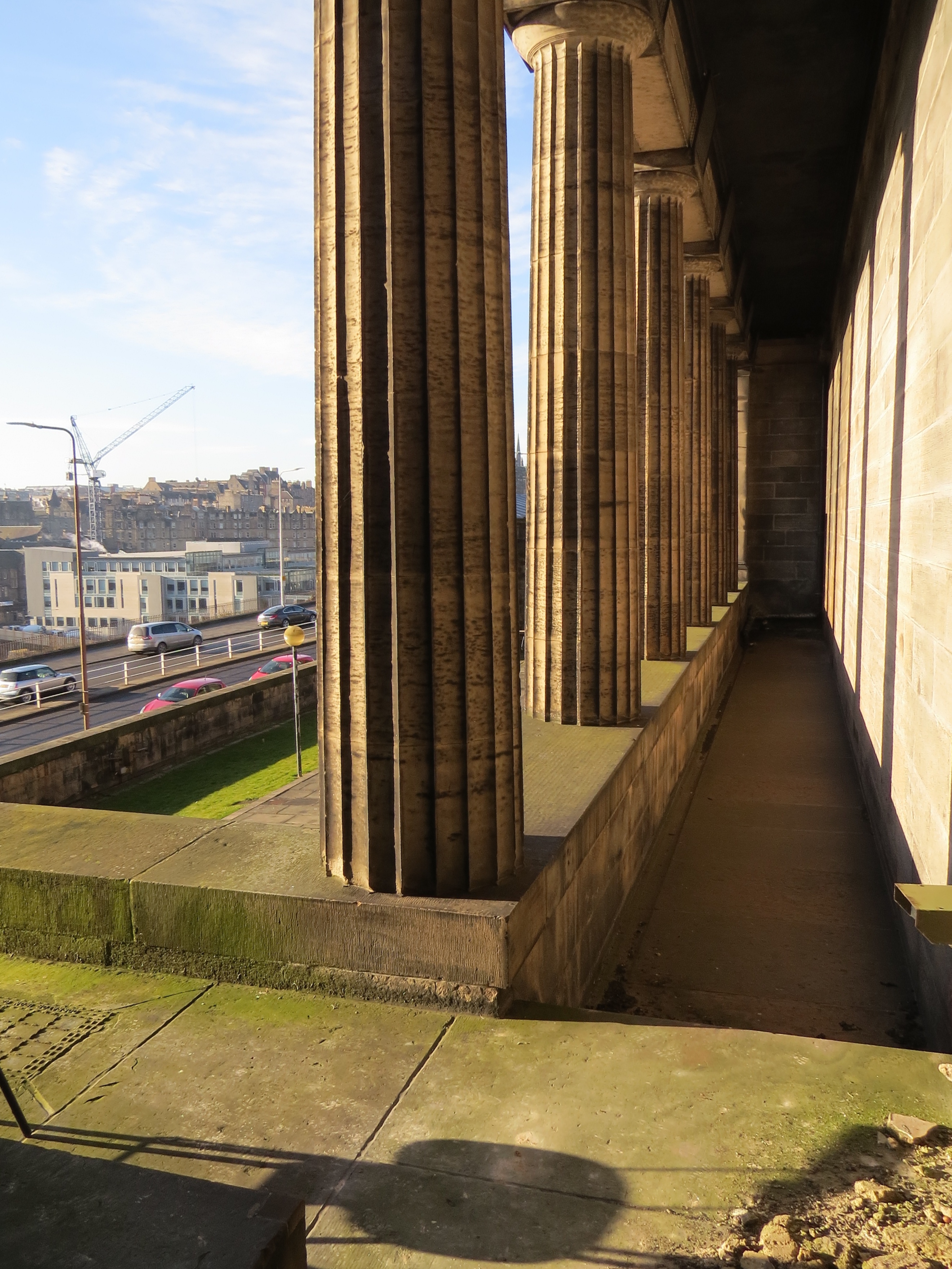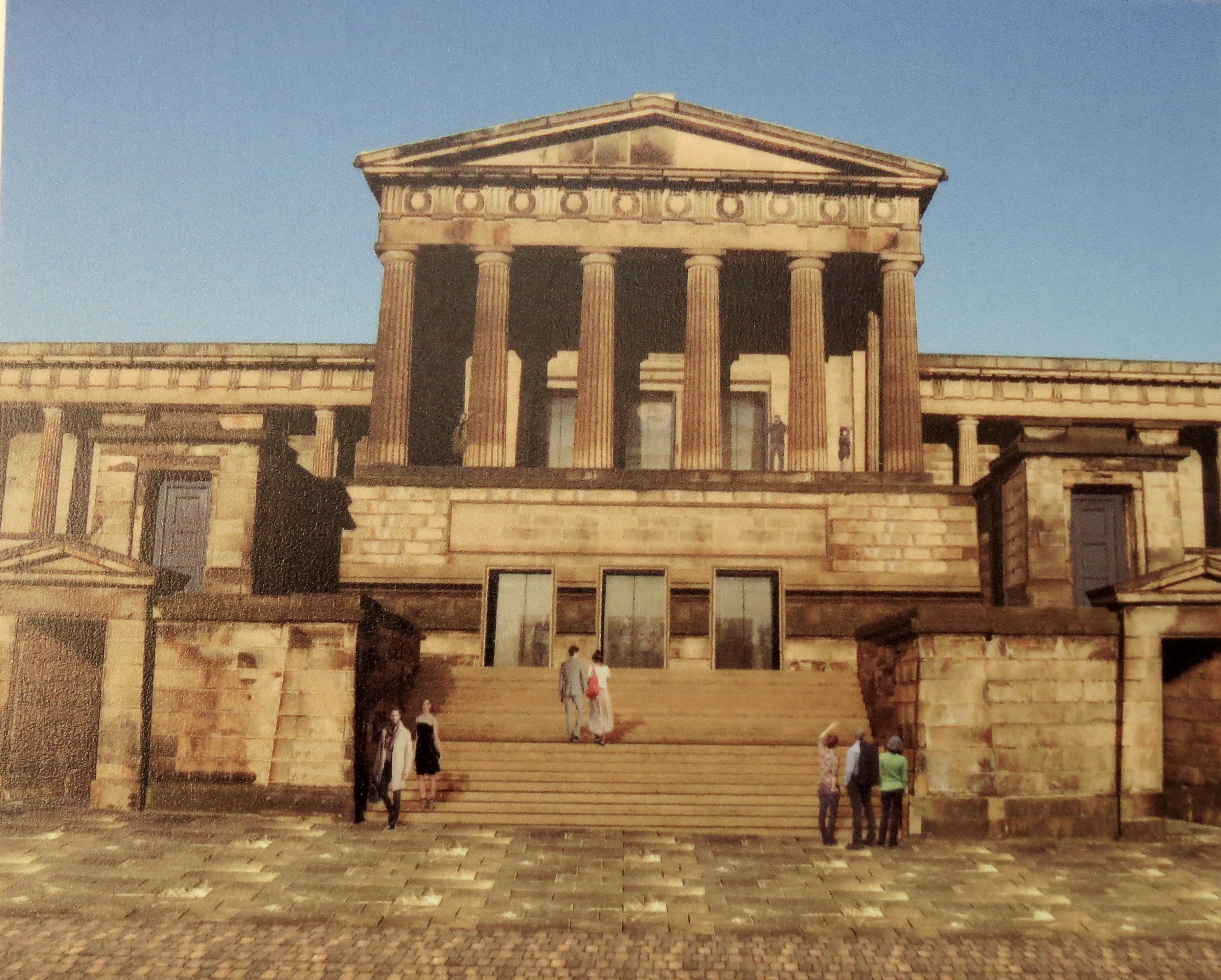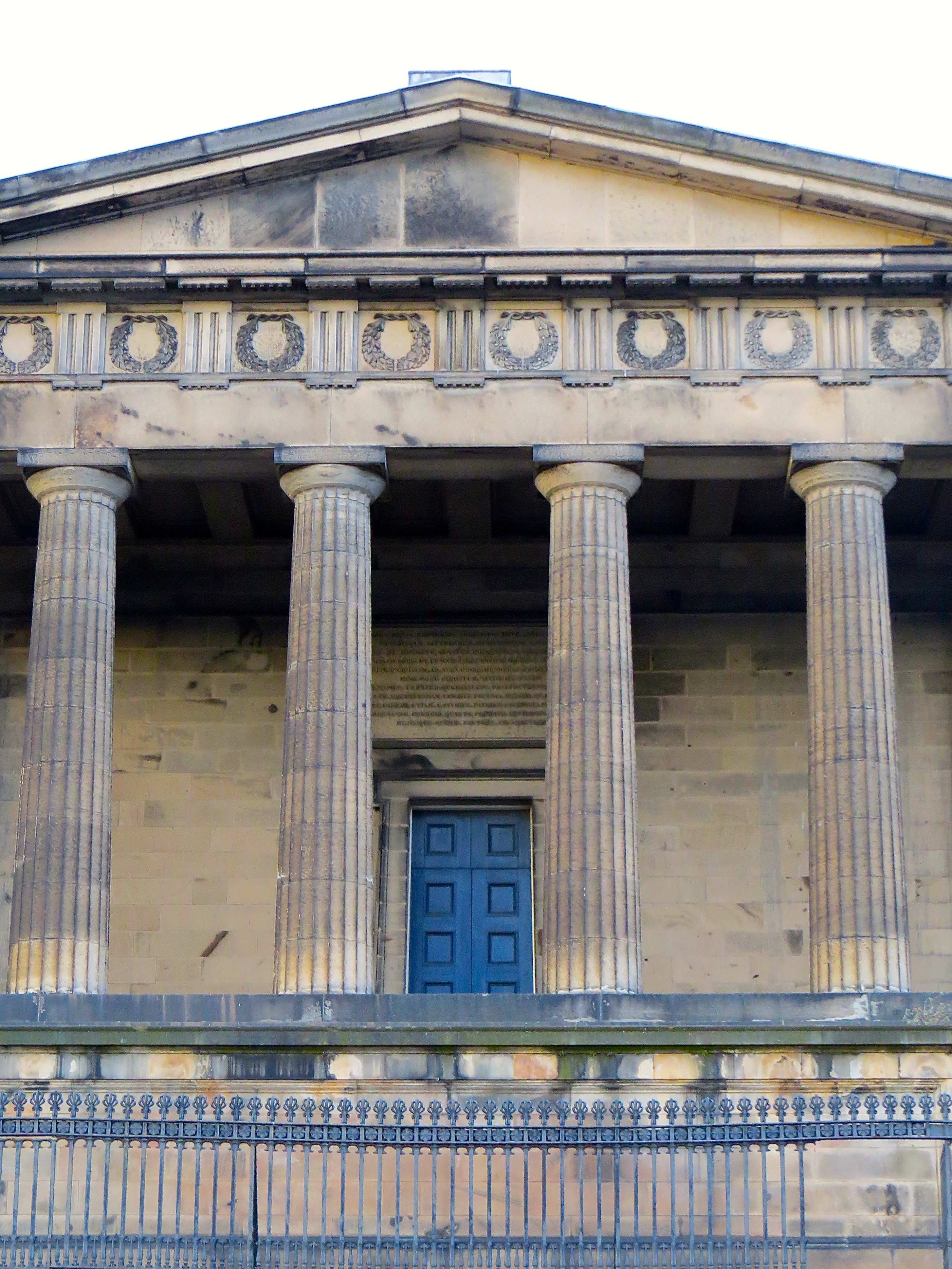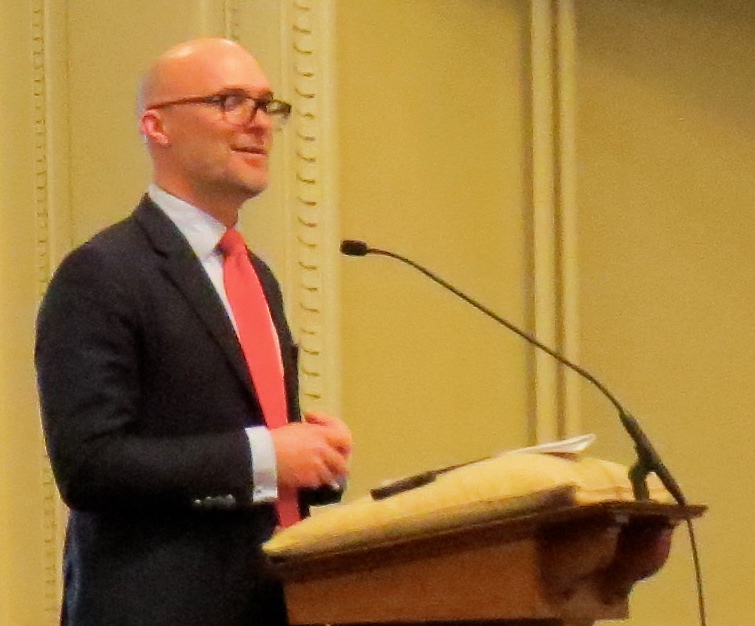
Plans to develop the old Royal High School are ‘the architectural equivalent of drawing Mickey Mouse ears and a moustache on the Mona Lisa’.
So said one critic at last night ‘s meeting to discuss the ‘iconic’ building’s history, significance and future.
Over 300 people had packed the ground floor of St Andrew’s and St George’s West. Most of them – judging by those who later raised points or applauded – opposed current plans for redevelopment of the former Royal High School (RHS) as a 300-bed luxury hotel and public exhibition space (Breaking news, 5.2.15).
The panel of distinguished guest speakers was also against the plans, although not surprisingly given that its members had been chosen because their views broadly matched those of the Forth & Borders Group in the Architectural Heritage Society of Scotland which organised the event.
Citing examples in Greece, France, Italy and Germany, he returned pointedly to the ‘massive, windowless and monumentally expressive form’ of the RHS’s blind portico. He stressed the long vistas towards its ‘rus in urbe' setting against the scrubby backdrop of Calton Hill.
He said that any redevelopment here must respect the ideals from which the structure’s principal characteristics derived. ‘Punching holes in it to improve 6-star tourists’ views’, and diminishing the setting by erecting new structures alongside, would not achieve a respectful solution.
Later he regretted Edinburgh's abandonment of its world-leading pro-conservation stance in the 1970s and 1980s. He criticised the RHS developers’ ‘nonsensical statement after nonsensical statement’, and called for scrutiny of their ‘pretentious claims’.
‘Do we even want 300 high-net-worth visitors in the city?’
It has cultural value (some would say merely mythological or rhetorical) as a symbol of Scotland’s post-Reformation emphasis upon socially inclusive, intellectual rigour and Enlightenment rationalism.
She advocated the application of 'soft power', public engagement, and more dialogue upstream in the planning process for the RHS.
One such element was how the capital’s buildings reflect not only the genius of their architects, but the ambition of Edinburgh’s 19th-century councillors to emulate Athens.
Similar ambition and vision, she said, was required of 21st-century councillors who could learn from their peers in Regensburg and Vienna about seeing World Heritage Site criteria and cultural, social, political and economic improvements as mutually reinforcing rather than self-contradictory.
An audible frisson in the audience greeted her blunt question: Is it acceptable to change this publicly owned site to private use? A transcript of her presentation is available at the foot of this page.
He passionately advocates finding new uses for old buildings, and is generally prepared to countenance necessary sympathetic additions to them in pursuit of imaginative commercial purposes.
In this sense, he was probably closest among the speakers to the position of the developers.
However, even Binney was deeply sceptical about current plans for the RHS, describing them as too ambitious in outline, and far too vague in detail.
Questions and comments from the floor followed:
- Author David Black lambasted Councillor Cameron Rose for his comments on there supposedly being too many listed buildings in Edinburgh. He described current proposals for the RHS as ‘unconscionable’. They were, Black said memorably, ‘the architectural equivalent of drawing Mickey Mouse ears and a moustache on the Mona Lisa’. He envisaged reinventing the RHS as a profitable international language school.

- Robert Robertson argued that buildings of international architectural significance should not necessarily have to earn their keep financially.
- Conservation architect James Simpson mooted a transfer of responsibility for the building to an independent body such as the Scottish Historic Buildings Trust, which specialises in preserving such sites and finding new uses for them. He wanted an educational or cultural purpose for the building, not a ‘nakedly commercial’ one.
- Marcus Binney was challenged to supply practical uses for the RHS. He said he had no definitive answers, but his experience told him that practically experimenting with uses soon suggested options.
- Architect Malcolm Fraser wanted the RHS to remain a public building. He was critical of what he saw as the developers’ manipulative PR management, not least in its questionnaire at last month’s PAN exhibition. However, he feared a 'public rammy’ would end up by producing some bland compromise of which there was too much in Edinburgh already. He said too little detail was yet available to consider current proposals as architecture.

- Marion Williams, director of the Cockburn Association, criticised the brief issued by CEC for the site as wrong. Prioritising ‘best [economic] value’ misunderstands the asset. She predicted similar concerns would arise around CEC’s other ‘big 12’ historic sites. She urged people to read the Cockburn's response here.
- Alan Welsh of the New Town & Broughton Community Council said Edinburgh risked losing its World Heritage status as Dresden had done. He won loud applause in calling for the city’s citizens to noisily and assertively reclaim Edinburgh’s development agenda from officials and politicians.

- Stephen Edwards of the Inveresk Village Society suggested the RHS could be a Museum of Scottish Architecture.
- Margaret Stewart of Edinburgh University’s School of Architecture said Hamilton’s ‘heroic, sublime, romantic classicism’ was a testament to a harsh education thrashed into generations of boys. It was now ‘obsolete’. She doubted Marcus Binney’s assertion that contemporary commercial uses for the RHS could be found without ruining it. It should be kept exactly as it is without new additions. A former RHS pupil later disputed Stewart’s depiction of the school as a kind of Dotheboy’s Hall. Its grand exterior disguised a small interior (‘typically Edinburgh … all show'). He said it could be run as a museum in and about the Royal High School.
- ‘Activist' Simon Byrom asserted that the Council’s financial predicament left it ‘wide open to public asset-stripping’, and he cited Craighouse, Caltongate and the Green Belt as examples. ‘The time is right to take a stand’, and to promote civic engagement through social media. He thought the RHS would make an excellent centre for the study and celebration of the Scottish Enlightenment.

Leitch closed proceedings at 8.45pm with news that, following his request in January, City of Edinburgh Council had urgently surveyed the building and was now putting repairs out to tender which should halt damaging water ingress. He concluded by reading the statement of architectural historian David Walker, famous as one of the authors of the Buildings of Scotland: Edinburgh:
This is not an Edinburgh storm in a teacup. It is an international scandal. That the architect is award-winning might be relevant in relation to a building of much lesser importance but not here. It is a question of how much international embarrassment the City of Edinburgh Council – and in turn Scotland as a nation – is prepared to countenance to secure a commercial fix to the long-running indecision on the future of this building when a proper cultural use should have been found for it.
This has been as impartial and complete an account of the meeting as we could manage. Make of it what you will. The overall tone was critical.
What surprised this observer was the level of suspicion and hostility reserved for City of Edinburgh Council. The evening's highly educated, well-informed and articulate assembly – comprising many ‘built-heritage professionals’ – was remarkable for how it:
- distrusted CEC’s apparent prioritisation of economic best value over cultural worth
- was sceptical about the probity and transparency of the process by which the Royal High School’s future was initially decided
- doubted the Council’s willingness or ability to protect the structure’s architectural integrity against what it sees as inappropriate development
- had little confidence in the Council’s competence to preserve and foster the World Heritage site.
It remains to be seen whether words can be turned into deeds. Will a new organisation or coordinated movement emerge from last night’s meeting to seize the initiative concerning Edinburgh's architectural agenda? AM
Got a view? Tell us at spurtle@hotmail.co.uk and @theSpurtle and Facebook
------------------------------
 Robin Gillanders Excellent reporting - again. I was involved with proposals for an international centre for photography at RHS. Plans had been drawn up - but due to a lack of will from CEC and HLF nothing came of it after almost 10 years of campaigning. Scotland is the only country in Europe that does not have a major Photography Centre despite the huge collections go valuable photographs and that Edinburgh (and Scotland) was in the vanguard of the development of photography in 19th century.
Robin Gillanders Excellent reporting - again. I was involved with proposals for an international centre for photography at RHS. Plans had been drawn up - but due to a lack of will from CEC and HLF nothing came of it after almost 10 years of campaigning. Scotland is the only country in Europe that does not have a major Photography Centre despite the huge collections go valuable photographs and that Edinburgh (and Scotland) was in the vanguard of the development of photography in 19th century.
@LoveEdinburgh @theSpurtle @edplanning What are viable, 'costed' alternatives? RHS building been in decay since I was at school there '50s
@theSpurtle Even La Gioconda herself would have a bit of a mona at these proposals.
Email from Caroline Roussot: On reflection, what I don't understand about all this is, we're told that CEC has granted a peppercorn lease to Duddingston House Property Ltd; we heard at this meeting that the Finance Committee selected Duddingston's proposal because its remit was to maximise the financial return to CEC. But what return does CEC get from this, other than getting the maintenance of the thing off its books? Do we know this?
@theSpurtle @LoveEdinburgh @edplanning Keep it coming ....it's an amazing building but needs to breathe. ...to be alive with people! #Smile

